Guaymas, Sonora 作者: 来源: 发布时间:2021-11-10
1. Population and Area
Pop: 134,153 (munip.)
Area: 12.206 km2 (city)
Elev: 10 masl
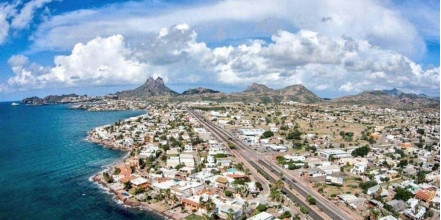
Guaymas location in Mexico within the state of Sonora
https://goo.gl/maps/o4EeobNe28NLMEqp7
2. Natural geography
Nature and weather
Hydrography
The Municipality has the Rivers: Matape, Bacatete, It has the Ignacio R. Alatorre Dam known as "Punta de Agua" and the hot water dam in Vícam with an extraction capacity of 15 million 300 thousand cubic meters of water and 345 kilometers lined conduit channels.
Orography
Most of its territory is flat, sloping from east to west and ends on the shores of the Gulf of California. Its main elevations are the mountains of El Bacarete, Santa Úrsula, San José, San Pedro, Luis Blanca and the hills of the Vigía, its coastline is mountainous in the middle part where the city of Guaymas is located, in the north and south areas the beaches are low and sandy.
Soil Geology is made up of layers from the following periods: Quaternary (55.05%), Tertiary (40.16%), Cretaceous (2.95%), Undefined (1.12%), Paleogene (0.64%), Neogene (0.06%) and others (0.02%).
It has an inactive volcano in the so-called "Sierra el Aguaje".
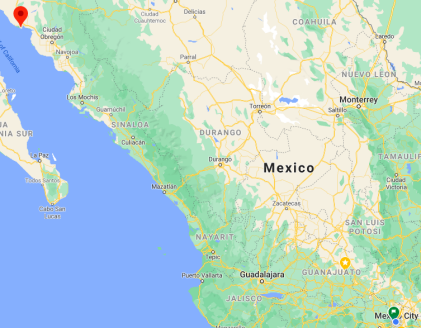
Flora and fauna
In the entire municipal territory there is mesquital type vegetation, in the center of the municipality you can find vegetation of the subinerme scrub type. An area for irrigated agriculture is located on the border with the municipality of Empalme.
Regarding the fauna of the municipality, it predominates: toad and bull toad, desert tortoise, cachora, chameleon, coralillo, chicotera, deaf viper, rattlesnake, cahuama, sea viper, mule deer, white-tailed deer, bighorn sheep, puma , lynx, coyote, wild boar, raccoon, squirrel, opossum, juancito, field mouse, cotton bristle rat, iguana, turtle dove, purple pigeon, owl, horned owl, arizona woodpecker, white necked raven, black bull, green heron, duck prieto, gray fox among many other species.
Protected areas
There are the Estero del Soldado, San Pedro Nolasco Island, Cajón del Diablo and Nacapule Canyon reserves with endemic species.
https://es.wikipedia.org/wiki/Guaymas_(municipio)
Köppen Classification: Tropical and Subtropical Desert Climate
his climate is dominated in all months by the subtropical anticyclon, or subtropical high, with its descending air, elevated inversions, and clear skies. Such an atmospheric environment inhibits precipitation. Most of Earth's tropical, true desert climates occur between 15° and 30° latitude. The most extreme arid areas also are far removed from sources of moisture-bearing winds in the interiors of continents and are best developed on the western sides of continents, where the subtropical anticyclone shows its most intense development. An exception to the general tendency for aridity to be associated with subsidence is in the Horn of Africa region, where the dryness of Somalia is caused more by the orientation of the landmass in relation to the atmospheric circulation. Both the high- and low-sun monsoonal winds blow parallel to the coast, so that moisture-laden maritime air can penetrate over land only infrequently.
The Köppen Climate Classification subtype for this climate is "Bwh". (Tropical and Subtropical Desert Climate).
The average temperature for the year in Guaymas is 77.0°F (25°C). The warmest month, on average, is July with an average temperature of 90.0°F (32.2°C). The coolest month on average is January, with an average temperature of 64.0°F (17.8°C).
The highest recorded temperature in Guaymas is 115.0°F (46.1°C), which was recorded in July. The lowest recorded temperature in Guaymas is 34.0°F (1.1°C), which was recorded in January.
There are an average of 8.0 days of precipitation, with the most precipitation occurring in August with 2.0 days and the least precipitation occurring in March with 0.0 days.
In terms of liquid precipitation, there are an average of 8.0 days of rain, with the most rain occurring in August with 2.0 days of rain, and the least rain occurring in March with 0.0 days of rain.
https://www.weatherbase.com/weather/weather-summary.php3?s=555267&cityname=Guaymas%2C+Sonora%2C+Mexico&units=
Getting there and around
Get there
By plane
Fly directly into Guaymas airport or fly into the state capitol of Hermosillo (125 kms. away from Guaymas) and take a bus (Tufesa) from the Hermosillo airport to Guaymas. Effective October 27, US Airways will no longer serve Guaymas from Phoenix AZ.
By bus
The cost of the bus varies by company and service. Costs range from 50 pesos from Ciudad Obregon and Hermosillo by 2nd class service. Luxury services TAP and Tufesa stops on the the main road in town, Serdan, close to the where it reconnects with Garcia Lopez, the main highway between Culiacan and Hermosillo. The rest of the buses including Estrella Blanca Group cluster around Calle 14 just a few blocks south of Serdan. This bus station is open 24 hours a day.
By ferry
The Guaymas-Santa Rosalia Ferry connects the Baja California peninsula every day between Guaymas in Sonora and Santa Rosalia in Baja California. This is very useful as people in Los Cabos or La Paz can go to mainland Mexico (and backwards) without having to take a flight or driving as far to the Colorado delta. Notice that you can take your vehicle with you in the boat. The ferry runs from Guaymas to the Baja at night and arrives in the morning to Santa Rosalia, returns to Guaymas and arrives there in the afternoon.
Car Rental – To explore Mexico’s provincial towns and cities—including its beach locations and the scenery and attractions near them— consider renting a car for your visit. Having your own car will give you more flexibility than using public transport options and, in some cases, offer you access to places which are otherwise difficult to visit without the use of a car.
COVID19 - International entry into Mexico from United States
Allowed for: All visitors arriving by air. Mexico land borders are closed to non-essential travel
Restricted for: There are no current restrictions.
Get around
By foot – The whole tourist industry lies on Benito Juarez, the main street in town. There's plenty of taxis as well. You're never without friends or drinking buddies as long as you have cash.
It is safe to walk around during the day. As with any new place, make sure you’re alert and aware of your surroundings. There is no standard height for curbs and the sidewalks are full of cracks, so keep your eyes scanning around and below you.
At night, it’s recommended to drive or take an Uber or taxi, which are safe and reasonably priced. You can ask for a restaurant or hotel to call a cab for you. If you choose to drive, street signs are well-lit, and you won’t have heavy traffic to contend with.
By car
Understanding Guaymas is simple. There are 2 main roads -- The highway and Serdan. Streets and Avenues are either north or south and are numbered.
Rent a car or use the city wide bus system which costs 7 pesos per trip (less than 50 cents). Lots of taxis available at a reasonable cost and many of the drivers speak some english. Trips to San Carlos (~10 km away) cost 12 pesos per trip, leaving from the central market, one block south of Serdan.
Taxis – Taxis in most of Mexico’s towns and cities are not metered, so agree your price before you get in. Taxi travel is very affordable in Mexico, in comparison to the USA, Canada and Europe, and so provides a viable means of public transportation in Mexico. Your hotel can arrange taxis for you; some post their rates on a board in the lobby; taxi hotel rates are usually higher than cabs you hail off the street. If you speak Spanish, you will have a distinct advantage and be able to negotiate a price with the driver.
Uber is expanding rapidly across Mexico and now offers services in cities across the country, including: Mexico City, Toluca, Cuernavaca, Puebla, Querétaro, León, Aguascalientes, San Luis Potosí, Guadalajara, Monterrey, Hermosillo, Tijuana, Mexicali, and Mérida. Uber has been adding Mexican cities to its network every year, check for availability when you arrive at your destination in Mexico.
Cabify and Didi are also developing and currently operate in cities including Mexico City, Toluca, Monterrey, Puebla, Querétaro and Tijuana. Check for availability in the city you are visiting.
These services offer people with smartphones a way to book a cab through a mobile app for a pre-agreed price. Fares are comparable with Sitio type cabs, and sometimes trade at a premium to this when local demand increases.
https://wikitravel.org/en/Guaymas
https://www.mexperience.com/transport/taxi-travel-in-mexico/#51
3. ECONOMY
GDP: 22,995 M MXN (2010, metro area)
https://imco.org.mx/ciudades2010/ciudades/39_Guaymas.html
4. Industry characteristics
Main producer and exporter of honey in Mexico, with quality and international recognition.
Fishing
It is the most important activity and main source of income; with large installed capacity for capture, processing, and commercialization.
Guaymense fishing employs 11,800 people in the catch, and another 325 are engaged in aquaculture. It contributes 70% of the total Sonora state fisheries production, with the main species caught being sardine, shrimp and squid.
It has 175 kilometers of coastline including important bays such as Guaymas, Lobos, San Carlos (Mexico) and the Herradura. The municipality has more than 83% of the docks operating in the State.
The fleet consists of 359 shrimp vessels, 32 sardineras, 3 escameras and 910 smaller vessels, for a total of 1,304.
55 percent of catches are sold in the State, and the remaining 45 per cent has as its final destination other parts of Mexico and the foreign market. Foreign exports are mostly shrimp, which has a high price in the international market, and makes Guaymense fishing very dependent on the conditions of this market.
80 percent of fishermen in coastal communities originate from the same region where they fish; 15 percent come from other localities of the state, and about 5 percent from other states, particularly Sinaloa and Nayarit.
Today fishing is considered the main activity generating employment and providing good income to the majority of the Guaymense population. This is due to lack of interest and investment of the government in fishing, as well as to the arrival of maquiladora (manufacturing) plants which compete with the fishing industry.
Agriculture
The irrigation infrastructure for agriculture in addition to 186 wells, also includes the Ignacio Alatorre Dam that is located in the Guaymas Valley with a total capacity of 27.7 million cubic meters; and the heat water repressive in Vícam with extraction capacity of 15.3 million cubic meters of water and 345 kilometers of coated conduction channels.
Agriculture in the municipality takes place on a total area of 42,291 hectares, of which 22,000 hectares are located in the Yaquis communities and the Guaymas valley. 17,296 hectares are irrigated, and 2,995 hectares of moisture or temporary.
The main crops are: wheat, soybeans, safflower, corn, cotton and some vegetables and fruit such as pumpkin and papaya
The cultivated area had a decrease of 2.3 per cent on an annual average over the past 5 years, from 51,850 hectares to 42,291 in the 1993-1994 cycle, a behaviour that was mainly influenced by the decline in sesame crops and sesame in that order of importance.
Even though the cultivated agricultural area declined in the last 5 years, the volume of production grew at an average annual rate of 2.5 per cent from 233,980 tonnes in the 1989-1990 cycle to 258,525 tonnes in the 1993-1994 cycle, growth that was founded on better crop yields, such as: soybeans and maize among others.
Livestock
In livestock activity, cattle ranching with 72,875 heads is the most important, followed by goats with 20,088 bellies, and lastly birds and other minor species.
The production of beef, milk and eggs decreased between 1990 and 1995, with the former decreasing from 81,830 to 72,875 head of cattle, while the production of pork and poultry grew. There are underutilized resources that with adequate support could generate significant income through agricultural integration by growing fodder crops in agricultural areas for harvest by grazing beef and milk cattle. Investments in the mechanization of meat and milk production, with support for the rehabilitation and modernization of pasteurizers, would also improve production.
Development of goat culture is also a promising possibility in locations that by their topography and vegetation are unfavorable to cattle.
Industry
The manufacturing industry producing food of fishery origin, both for human and animal consumption, stands out as the main branch of activity.
The industrial fishing plant consists of 5 canneries, 8 flours and 12 frozen food plants, all located in the Port of Guaymas.
Over the past 3 years, the local fishing industry workforce has declined from 4,153 jobs to 2,153, a declining rate of 28 per cent on an annual average.
Likewise, the Port of Guaymas has had an important growth in the maquilading sector of the aerospace sector, placing Sonora as the nation's third largest supplier for this industry. Just as the aerospace industry has grown, so also has there been important growth in automotive and medical investment, because of its proximity to the Guaymas border has become a very attractive place for foreign investment in recent years. In the construction industry there are 32 companies that are engaged in the construction of homes and real estate in general, and another 10 to the construction and repair of boats; the former generate a total of 300 jobs and the second 559 jobs, between plant and eventual workforce.
Tourism
Guaymas offers many tourist attractions such as: Golf, snorkeling, sport fishing, horseback riding, ecotourism tours, cycling, diving and kayaking. "Citationrequired".
Thanks to the Only Sonora' program, unique in the country, vehicles can be brought from the United States without paying or carrying out formalities and permits, from Nogales to Empalme.
The tourist area of the beach, is located northwest of the port, being the region of the Bay of San Carlos (Mexico) and its surroundings and to a lesser extent the Bay of Bacochibampo or Miramar.
It also has 4 tourist condominiums, 2 marinas with spaces to accommodate 798 boats, and 5 fields for trailers with a total of 729 spaces.
Technical classes are offered in school to train citizens in community tourism jobs.
The local hotels in Guaymas-San Carlos have an average annual occupancy rate of 41.8%, reaching 100% during busy seasons, which keeps Guaymas as a focal point in Sonorense tourism.
Key project: Sonora desalination plant
The desalination plant contemplates a production of 200 liters of water per second, which translates to 6,307,200 m3 per year. This flow will supply more than 226 thousand inhabitants of the municipalities of Guaymas and Empalme in the first stage.
The investment scheme includes a subsidy of 49% from the Federation and 51% from private participation.
The main objective of this project is to address the existing problems in these municipalities with respect to the deficit in the supply of drinking water that does not allow meeting the needs of use and consumption of domestic, commercial, industrial and public users.
The amount of the investment is almost 800 million pesos in exchange for a 20-year concession for its operation and exploitation.
The Aqualia company, in association with Seyses, projected the delivery of this plant by mid-2020.
http://desaladora.sonora.gob.mx
https://www.eleconomista.com.mx/estados/Aqualia-establece-fecha-de-entrega-de-planta-desalinizadora-en-Sonora-20190218-0136.html
5. Attractions
El Soldado Estuary
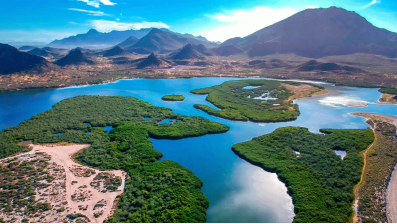
20 kilometers northwest of Guaymas and 10 kilometers from San Carlos Nuevo Guaymas, is the Estero “El Soldado” (Estuary “The Soldier”), an exceptional biological richness lagoon.
On foot, by bicycle or non-motorized boats, go into an adventure world to discover the area’s species such as blue herons, terns, crabs, mullets and oysters. The site serves as the reproduction, shelter, breeding and feeding place of a resident and migratory species’ great diversity.
“El Soldado” was declared a State Protected Natural Area in 2006. 231 of its 322 hectares are the Core Zone, including the lagoon body and the maritime terrestrial area.
Enjoy a tour for the Sendero Interpretativo (Interpretive Trail), where you’ll get to know the site’s flora and fauna. Then, make the most of the three dimensions trip that will connect you with the Sea of Cortés and other natural wonders.
You can also go on a kayak tour for enjoying the estuary's great biodiversity. If you prefer to do a little exercise, cycle it and watch the birds of the zone such as hawks, owls and eagles.
https://www.visitmexico.com/en/sonora/guaymas/estero-el-soldado-estuary-the-soldier
Guaymas Historic Center
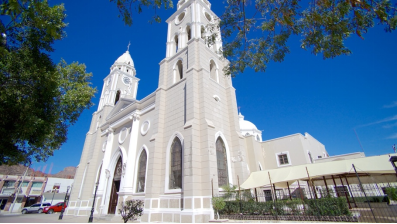
Walk through 23rd and 24th streets and Serdán and Abelardo L. Rodríguez avenues, in the Historic Center. There, the Plaza de los Tres Presidentes was built, which honors the Mexican presidents this city born: Adolfo de la Huerta, Plutarco Elías Calles and Abelardo Rodríguez.
Stop for a moment in front of the 19th century Templo de San Fernando, the neoclassical architecture port's main church. Further on is the Templo del Sagrado Corazón (Temple of the Sacred Heart), the oldest of all sanctuaries.
Going down these roads, you can see the 1861 Bank of Sonora emblematic construction. Then continue with the fascinating and noticeable 1899 City Hall stone structure. The Old Public Prison, from 1890, still preserves its cells and patios; now is a gallery and exhibition center.
https://www.visitmexico.com/en/sonora/guaymas/historical-center
Pearl Farm of the Sea of Cortez
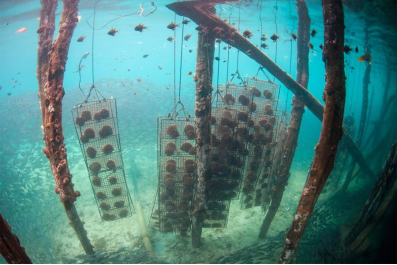
Did you know that Guaymas, Sonora, has the most beautiful and highest quality pearls in the world? To learn more about its interesting cultivation process you have to visit the farm “Perlas del Mar de Cortés” (Pearls of the Sea of Cortés) in Bahía de Bacochibampo.
During the facilities tour, you’ll learn about the history, how they’re formed and even the effort that their formation requires. Its iridescent tones beauty, as well as its size, is the pearls main characteristic.
The farm is a Mexican company that began as a research project on native pearl oysters and has developed a strong commitment to the environment. It’s known that the pearl produced is 100% natural; about four kilos of gems are obtained per year.
A specialized guide explains that harvest takes four years, necessary time for constant working on the oyster maintenance and withstand the hurricanes-and-climate-change onslaught.
Once you know all the production processes, the nets they use and their life cycle, you can buy some specimens and see those already decorated in rings, bracelets and necklaces.
https://www.visitmexico.com/en/sonora/guaymas/granja-perlas-del-mar-de-cortez-pearl-fram-of-the-sea-or-cortez
The Beach and Seafood in GUAYMAS, Mexico
https://youtu.be/UqUo6KxGyYw
6. History
Before the arrival of the Europeans, the areas now known as Guaymas was dominated by the Guaymas, Seri and Yaqui tribes. In 1539, two Spanish ships, the Santa Agueda and El Trinidad, arrived in Guaymas Bay. They were commanded by Francisco de Ulloa, who called the area "the port of ports."
Some small Jesuit missions in the area were founded in the 1610s and 1620s, when Jesuits founded eight mission villages with the Yaqui. The Seri strongly opposed the settlement of Europeans and resisted fiercely until 1769.
Juan María de Salvatierra and Eusebio Kino asked for permission to evangelize the area, which was received in 1697. In 1701, Salvatierra came to this area and established the Loreto mission somewhat inland from where Guaymas is now. To receive supplies by ship and evangelize the Guaymas Indians, the Jesuits founded another small mission on the bay, which they called San José de Guaymas. It was headed by Manuel Diaz. The Seri repeatedly attacked the San José mission, forcing it to be abandoned and rebuilt several times. The last time this mission was abandoned was in 1759.
In 1767, Viceroy Marqués de Croix ordered a major military offensive, the Sonora Expedition, to subdue the Seri and Pima tribes. After doing so, the Spanish colonials built an adobe fort with four towers in Guaymas, initially under the command of Captain Lorenzo Cancio. No traces of the fort remain today, but the San José mission is marked by a church located on the road leading to Empalme. Around the same time, the colonists formally mapped the Guaymas Bay and officially founded the city of Guaymas in 1769 by José Gálvez in Real de Alamos on behalf of the viceregal government. Despite the decree, no colonists settled there until the early 19th century.
In the late 18th and early 19th century, there was supposedly only one inhabitant in Guaymas, called “Tio Pepe” (Uncle Pepe), who was said to be a drunk and a thief. At the beginning of the 19th century, the village began to be populated by farmers and ranchers, who held large properties but did not have markets for their products. Farming was on a subsistence level. In 1811, commercial maritime traffic was authorized, and customs were established later in 1823. Guaymas received the name San Fernando de Guaymas in 1820. Ships visited the bay intermittently but only one house was here for customs purposes. In this era, it was safer to travel by sea than by land; Guaymas became an important stopping point for those heading north or south. The first commercial imports came through here in 1827. With the population of the area by European-Mexicans, the Guaymas moved to a town called Belén. They eventually disappeared as a distinct group.
The port became a municipality in 1825. During the Mexican–American War, American warships such as the Portsmouth, the Congress, the Dale and the Argos anchored here near the Pajaros Island and the Almagre Grande. The ships fired on the town and captured it, keeping it in U.S. hands from 1847 to 1848.
In the mid-19th century, Guaymas was the target of several filibusters, or unauthorized military expeditions from foreign nations, designed to foment rebellion. One was done by the crew of the English sailing vessel “Challenge” and a French ship named La Belle commanded by Count Gastón Raousett-Boulbón, who intended to take over all of Sonora. The French attacked the city on 13 July 1854, but the port was successfully defended by José María Yáñez. A firing squad executed the count soon afterwards. The national government elevated the town to city status as a reward for this action in 1859. Later, in 1935, it gave Guaymas the title of “heroic city” for the same action. The municipality's formal name of Guaymas de Zaragoza was authorized in 1862. In 1865, French ships arrived to attack Republican forces, which were forced to retreat. The French occupied the city until 1866.
By 1890, the city had 10,000 residents and was somewhat prosperous. The Carnival tradition it established then continues to this day.
On October 4-5, 1911, Guaymas was struck by major hurricane and accompanying storm surge which killed some 500 people in the city and environs.
During the Mexican Revolution, the first ever aerial bombardment of a naval target occurred just off the coast of Guaymas: in 1913, five military ships belonging to Federal forces appeared in the bay, and General Alvaro Obregon of the rebel army ordered the bombing of these ships using the aircraft “Sonora.”
The first modern port facilities were built in 1925 for the Mexican navy. In 1942 a commercial pier and warehouse were built at La Ardilla. Guaymas’ importance as a port grew in the 1950s, and in 1961, a pier for the national oil company PEMEX was built. A naval ship repair station, called the Varadero Nacional, and silos for the export of grain, called the Almacenes Nacional de Depósito, were built in 1964.
Ferry connection with the city of Santa Rosalía, Baja California Sur was established in 1972. In the 1980s, a number of private construction projects further enlarged the port, including those built by the Compañía Mexicana de Cobre, Cementos Tolteca and Compañía Mexicana de Ácido Sulfúrico. Due to changes in Mexican maritime law, a private company under contract to the government, Administración Portuaria Integral de Guaymas, took over port operations in 1995.
7. Other Information
The day Charles Chaplin got married in Mexico
In 1924, this news was broadcast on a radio station in the north of the country: “The film entrepreneur, Charles Chaplin and Miss actress Lita Gray got married yesterday, November 26, in the town of Empalme, Sonora… happy couple was passing by when… etc. etc." This is his story.
Few knew this unusual and unusual news, what would be the real reason, for the genius of the silent film, to choose a small town in the state of Sonora, to get married ...?
Why choose a town unknown to most and not a famous city? And above all, why in Mexico? The questions are many ... And concrete answers, none. We only find speculations and hypotheses.
The rise to fame awakened in Charles Chaplin a couple of weaknesses that he did not know; lust and infidelity. Behaviors and pleasures, which in the future, would greatly diminish his prestige, throughout his entire film career.
The young actresses, his main weakness, made his incorrigible heart beat. And his love affairs with the protagonists, followed one after another, emulating his famous song: –among “footlights” I saw you, between footlights I loved you. His first romance was with the actress Mabel Normand, followed by the other young actress, 16 years old, Mildred Harris with whom he married in 1916. A year later, during the production of the film Esasany became involved with Edna Purvance, their romance lasted a little over two years.
By 1918, the romance with Purvance ended. And at the end of that same year, the divorce with Mildred Harris was imminent, without any possibility of reconciliation. The relationship with Purvance was resumed, but only in the labor sense, this agreement strengthened a discreet and solid friendship between them. She starred in many films for him and he kept her on the payroll until his death in 1958.
In 1921 during the film "The Kid" he met the adolescent 13-year-old actress Lillita Louisa McMurray. Later she would be called "Lita Gray". Around that time the face of the beautiful Polish vampire appears; Pola Negri, with this actress, had a public romance for the only time, for a space of 14 months. In comparison, he struggled to keep his other romances hidden (usually without success).
In the course of those years, she wooed, behind the scenes, the innocent Lita and at this time, another actress appears in her life, the blue-eyed blonde, Marion Davis, partner of the millionaire, William Randolph Hearst. Romance arises between them and the encounters are continuous and inevitable. But the romance stops due to an unforeseen event. Marion and Charlie are seen on Hearst's yacht and a week later the mysterious death of tycoon Thomas Harper occurs on the same yacht. The press points to them as possible suspects, in the mysterious death. Charlie marries and is away for a few months, then resumes their romance until 1931.
What follows are different hypotheses and opinions. Applied to a behavioral logic. The true reason for the events ... we do not know.
The great Charlot had almost no friends, his brother was the only close confidant. They both analyzed the situation and his brother suggested that he marry Lita and take a vacation of several weeks outside the country. Thus the event, for which his enemies would give everything, to be able to involve him. He would stop, for the mere fact of being absent, and also protected, by a correct justification, then all interest of the press would be diminished, for harassing him and getting any statement from him. Charlot decides to invite Lita and her mother to vacation with him in Mexico, just for a few weeks and, above all, traveling by railroad. They accept and the journey begins, crossing the border by the new railroad crossing the State of Sonora until reaching the new municipality called "Empalme", located on the shore of the Sea of Cortez.
This small town is home to a North American community. It got there as a point of strategy. Previously, the Government of Porfirio Díaz had signed with the company Atchison Topeka & Santa Fe a concession contract for 100 years to build a city and its general workshops, as a central point, for all rail transport in the northeast of the country.
One of the inhabitants of the North American community, through a brother who works in Hollywood, has a friendship with Charlot and he is invited to spend a few days in Empalme. The new fiancée is indulged in all kinds of flattery by Chaplin. They are welcomed by their friend and hosted in one of the houses in this community. It is not known with certainty the date on which he arrived in Empalme, nor at what moment he decided to marry Lita Gray.
There is only one document that verifies your stay in Empalme, a marriage certificate. It is in the archives of the Civil Registry of this municipality under the faith of Judge Ignacio Raro.
Charly had promised a star to Lita in the movie "The Gold Rush", they did some rehearsals and tests, the film was delayed and Lita Grey's pregnancy became more noticeable. Finally, although she filmed some scenes, she had to be replaced by another actress.They had two children, the actors Charles Chaplin Jr. (1925-1968) and Sydney Chaplin (1926-2009) the marriage was a disaster, three years were enough to divorce and another year between courts to be able to carry out the same.
This process was very bitter for Chaplin. A judge forced him to pay Lita Gray an award of US $ 825,000, plus the judgment, an amount that amounted to more than a million dollars in legal costs. Aggravated by this, he had a federal tax dispute for a few years. Other scandals followed, and the hectic life she led caused her stress, leading to premature graying. The marriage of Gray and Chaplin inspired Vladimir Navokov to write the successful novel "Lolita", 1950. Years later, in 1962, "Lolita" would masterfully take her to the screen, the Director and screenwriter; Stanley Kubrick.
https://destakados.net/el-dia-en-que-charles-chaplin-se-caso-en-mexico
8.Contact Information
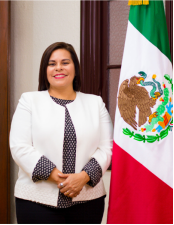
City Mayor: Sara Valle Dessens
Contact number: +52 (622) 222 2130
Govt. Office Address: Avenida Serdán #150 Calles 22 y 23 Col. Centro, Guaymas, Sonora.
FB: https://www.facebook.com/H.AyuntamientoGuaymasVa
Twitter: https://twitter.com/DessensValle
Website: http://guaymas.gob.mx
E-mail: presidencia@guaymas.gob.mx
